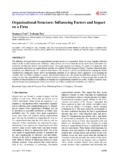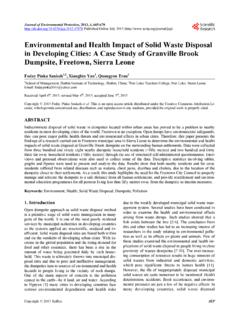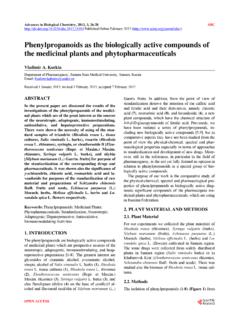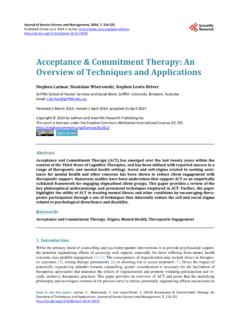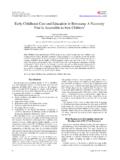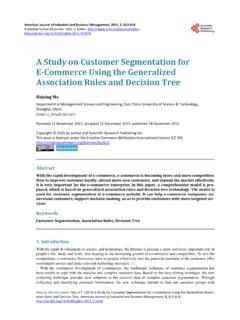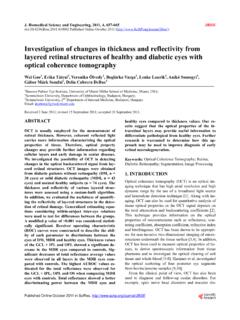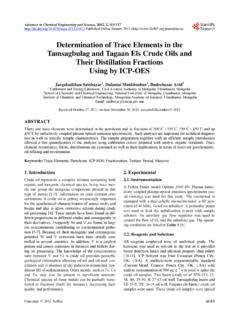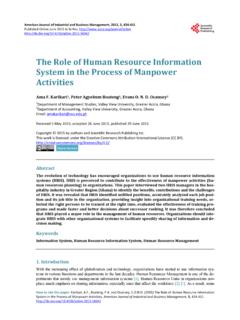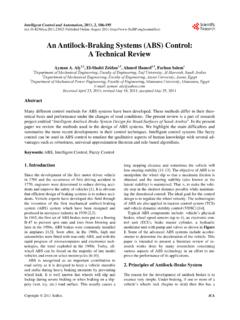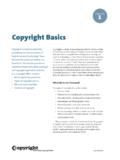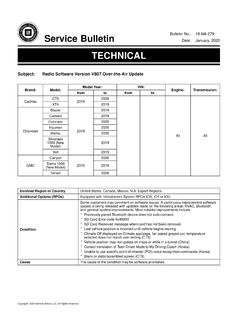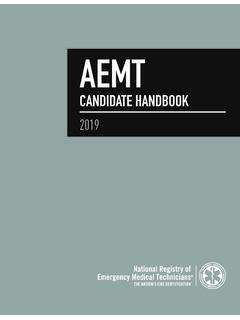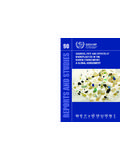Transcription of The Culture Turn in Translation Studies
1 Open Journal of Modern Linguistics, 2014, 4, 487-494. Published Online October 2014 in SciRes. The Culture Turn in Translation Studies Chen Yan, Jingjing Huang School of Foreign Languages, China University of Political Science and Law (CUPL), Beijing, China Email: Received 20 August 2014; revised 30 August 2014; accepted 5 September 2014. Copyright 2014 by authors and Scientific Research Publishing Inc. This work is licensed under the Creative Commons Attribution International License (CC BY). Abstract The Culture turn of Translation Studies was initially put forward by Bassnett and Lefevere (1990). cultural approach in 1990. As important representatives of cultural approach in Translation stu- dies, Bassnett and Lefevere attached great importance to the role of Culture in Translation , the so- cial background, the influence that cultural tradition imposed on Translation , the subjectivity of translators and researching shift from linguistic to Culture , thus improving the literariness of translated texts.
2 Such method of study expanded the scope of Translation Studies enormously, opened a new field of study, thus it enhanced a further and more comprehensive development of Translation Studies . This paper will present a brief introduction of the history of Translation stu- dies, analyzing the social causes of Culture turn and especially discuss the series shifts brought by Culture turn in status of translated texts and translators, and the methods of Translation analysis. In the end, some personal viewpoints will be showed about the Culture turn in Translation Studies . Keywords Cultural Approach, Culture Turn, Translation Studies 1. Introduction Since the creation of languages, Translation began to come into being. Though Translation has a long history, in the beginning, people simply translated just for communication and then made sense of what the other party ex- pressed. In general, at that time, there existed no professional translators for the sake of popular self-contained life style.
3 However, industrial revolution opened the door of socialization big production, and the productivity was soared and new vehicles came up. So products were sold to every corner of the world to gain excessive profits and cheap raw materials were imported from other countries. As the increasing exchanges among differ- ent language areas in trade, Translation was playing a more and more important role in communication, and pro- fessional translators began to work for the massive needs. In the late 1970s, Translation Studies began to be taken seriously by some linguists and Translation theorists to give a guide of a proper and suitable Translation . Then a How to cite this paper: Yan, C., & Huang J. J. (2014). The Culture Turn in Translation Studies . Open Journal of Modern Lin- guistics, 4, 487-494. C. Yan, J. J. Huang special science Translation Studies arisen. A number of researches have been conducted to investigate the Translation methods.
4 Since the late 1970s, the linguistic approach of Translation substituted for the originally dominated word-to-word method which was usually obscured for readers. And the dynamic equivalence was put forward by Nida, which marked a new ad- vance in Translation Studies . Nida who was a Bible translator has pointed out that the relationship between re- ceptor and message should be substantially the same as that which existed between the original receptors and the message (Nida, 1964: p. 159). From his point of view, Translation should vary for the sake of different readers. For example, Translation for children must be easy to understand and interesting to convey the surface meaning, whereas for expertise must be professional. Chinese famous Translation theorist, Ye Zinan thought highly of Ni- da's ideas in his book Translation Theory and Practice. Dynamic equivalence was indeed a prominent advance in Translation Studies .
5 In his theory, he began to throw away the simply literal Translation and took the different social background into consideration. He paved a way for the cultural approach in Translation Studies . Nida was honored with the patriarch of Translation Studies and a founder of the discipline (Ma, 2010: p. 4). However, in his practice, he just paid attention to the local habit of language use, emphasizing the language equivalence but irrespective of other social and cultural elements, which might made the texts understandable. At the same time, this method was hard to meet the need of massive Translation and the target readers were hard to determine, es- pecially the literature's readers. Considering that, Hans J. Vermeer created skopos theory, announcing that Translation is a type of human action, an intentional, purposeful behavior that takes place in a given situation (Ma, 2010: p. 81). Skopos, the intention of Translation , determined the Translation methods and strategies (Xie, 2012: p.)
6 159). From this respect, the status of source text was decreased, and more attention was paid to the function of the translated text. However, it was almost suitable and valid for advertisement Translation which at- tached more importance to the effects of ads and some other non-literal texts (Ma, 2010: p. 90). Then Christiane Nord added loyalty to such sokops theory, emphasizing the translators' responsibility toward the author, the in- itiator and the target recipient (Nord, 2001: p. 14). In other words, Nord's theory was similar to Nida's. Though all of these scholars built up their theories upon linguistics, they began to recognize the social elements. Poly- system theory came into being under such circumstance, breaking the boundary of traditional linguistics and Culture . Polysystem theorists thought the receptor's social norms and literary tradition decided translators' Aes- thetic hypothesis, and then influenced the Translation procedure (Liao, 2006: p.
7 61). Itamar Even-Zohar divided literature into center and periphery , and the Translation differed according to it. If a kind of literature was young or periphery in a nation, then the Translation should dominated and was foreignized to import more new ideas. If the literature was strong or center in a society, then the Translation should be domesticated based on lo- cal Culture tradition. But just as Xie Zhentian has pointed out: How to define center' and periphery'? Is this a political or a literary standard? (Xie, 2012: p. 219) Though Toury and some other theorists developed polysys- tem, they could not avoid such flaws. Based on the above researches, in the 1990s, Translation , History and Culture co-authored by Susan Bassnett and Andre Lefevere formally put forward the idea of Culture turn, which aroused many scholars' attention. They advocated cultural approach in Translation Studies to combine cultural factors such as sociology, psychology with the Translation and to improve the literariness of translated texts.
8 Un- til now much research has done in Culture turn Translation Studies , but some questions still remain to be further clarified, especially some questions about Culture . Some disputes on when Culture turn began, why Culture turn was necessary and how to balance cultural factors and sense still existed. The purpose of this study was to investigate the Culture turn in Translation Studies . Three questions were listed as follows: 1) why is Culture turn there in Translation Studies ? 2) How does the Culture function in translated texts? 3) How does the Culture turn affect the Translation Studies ? The study was in four phases. In phase one, a brief study of the history of Translation Studies was carried out to present the general development of Translation Studies , clarifying the tendency of its development. In phrase two, a research of social causes of Culture turn will be conducted. In phase three, some analysis on the shifts that Culture turn has brought in Translation Studies will be presented.
9 In phase four, some advice on how to practice Culture turn in Translation would be given for the sake that all the theories come from practice and should be ap- plied in practice. 2. The History of Translation Studies Translate has two meanings to change speech or writing into another language; to change something from 488. C. Yan, J. J. Huang one form into another (Yang, 2009: p. 2136). Here, the translate this paper discussed only refers to the lan- guage shifts of writing. And, Translation also has two meanings the act of translating something or some- thing that has been translated (Yang, 2009: p. 2136). So generally, Translation Studies involve the research of the process of translating and the translated texts. However, this paper tend to the study of the process but a simply study of the translated texts. Linguistic Approach in Translation Linguistic approach was a milestone in the development of Translation theories.
10 Its main representative was Nida who published his masterpiece Toward a Science of Translating in 1964, emphasizing transformational gener- ative grammar which was created by Chomsky. Nida pointed out that every sentence had its essential meaning, which was unchangeable even as the language changed, and he called it as kernel sentence (Liao, 2006: p. 58). In his theory, every sentence can be analyzed and found out the underlying meaning which did not depend on the words but existed forever. Of course, it can be transformed into another language with different structure. Based on this theory, it can be seen the shift from literal Translation to free Translation , irrespective of the form of texts. It emphasized the contexts and gave both of the source-language reader and the receptor-language reader the same understanding, which was called dynamic equivalence. Nida' theory was praised by scholars from the world, especially Chinese scholars such as Ye Zinan and Ma huijuan.
